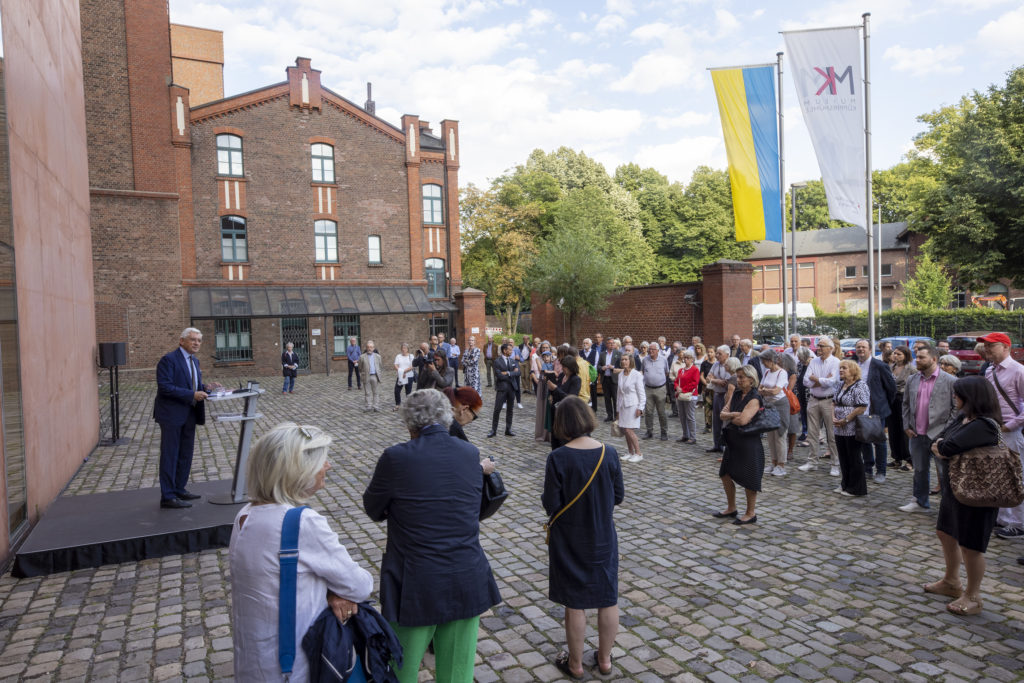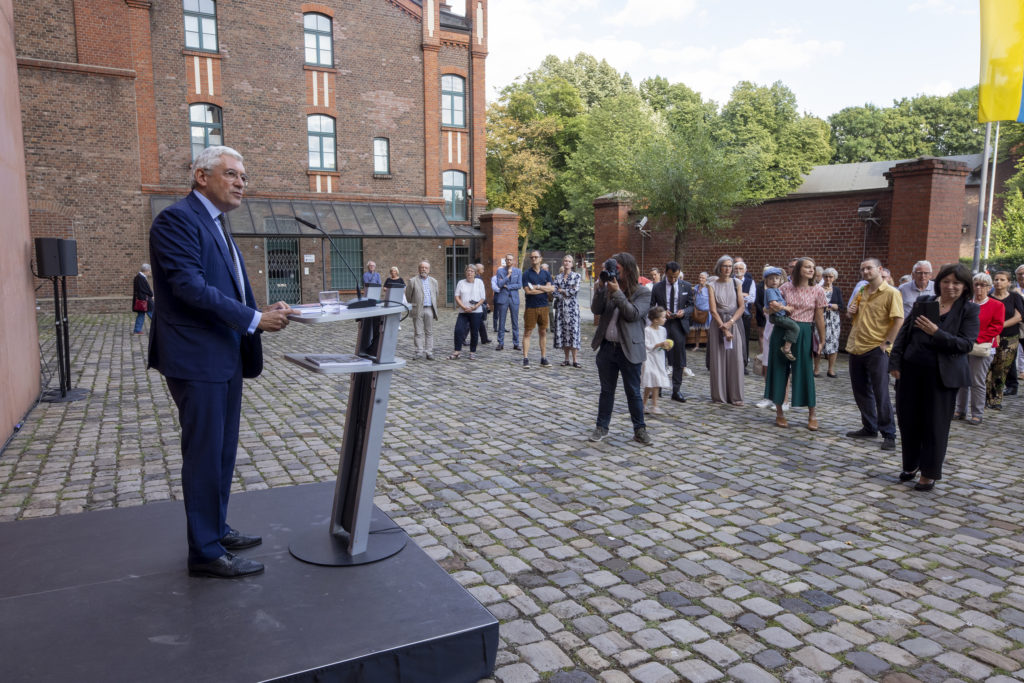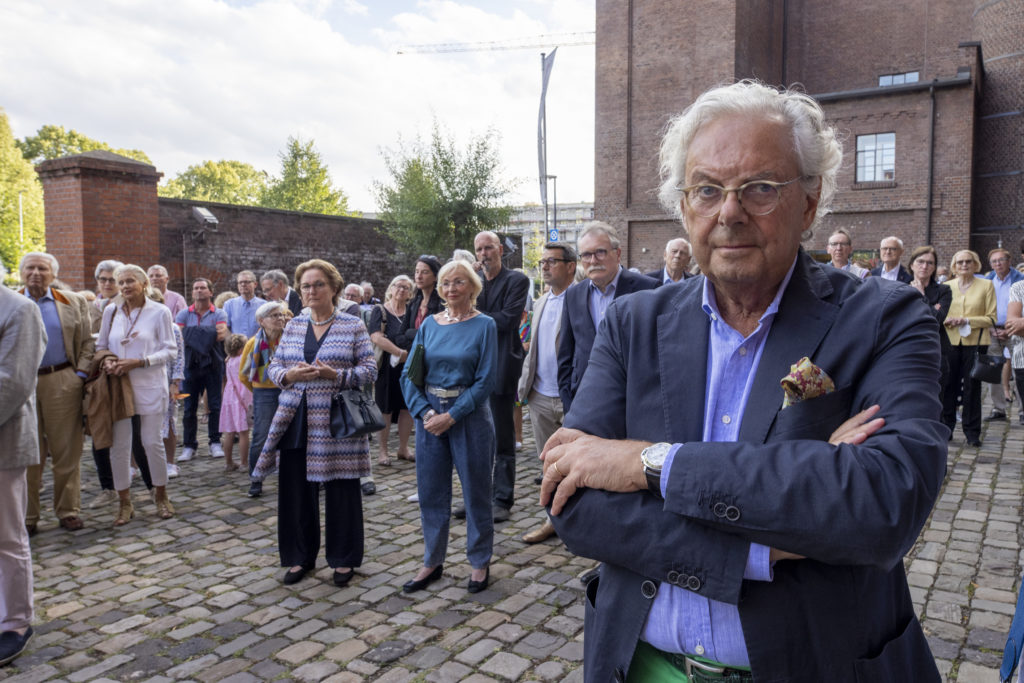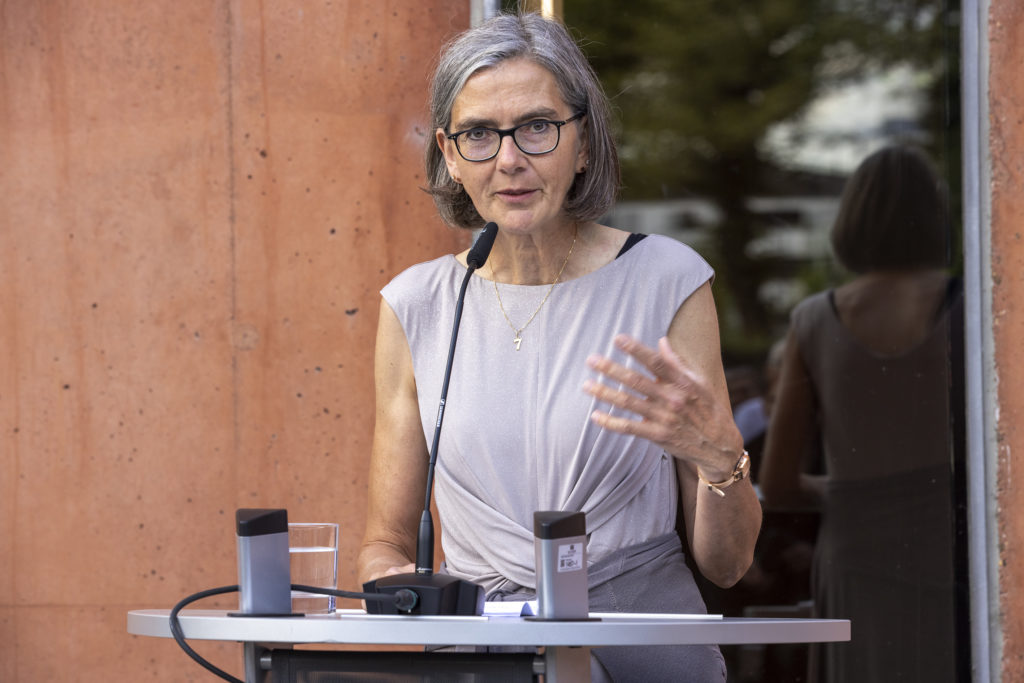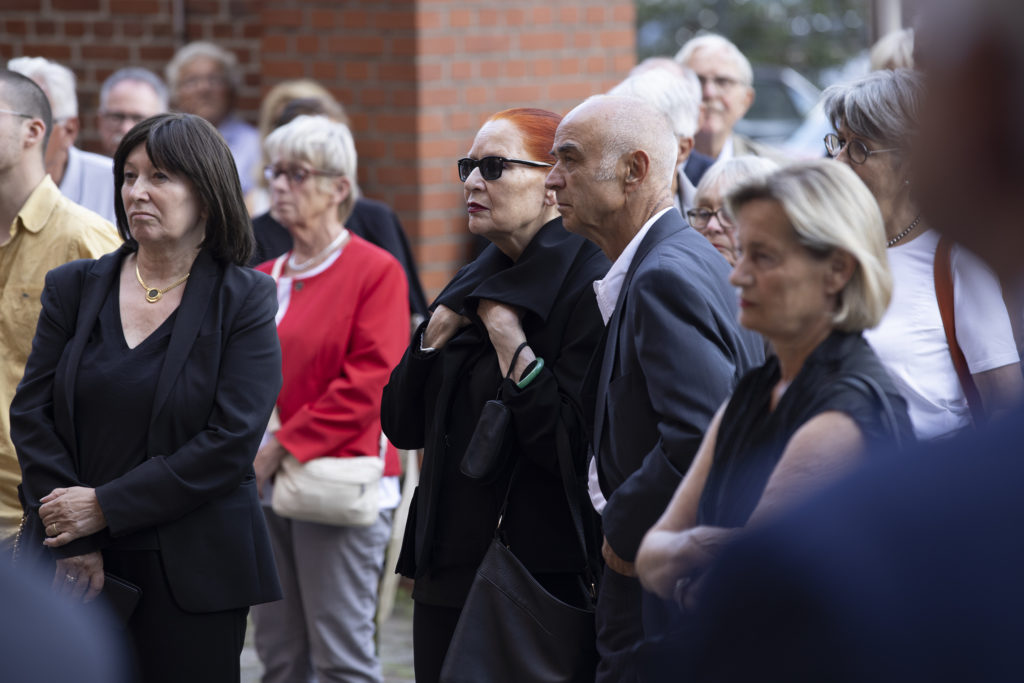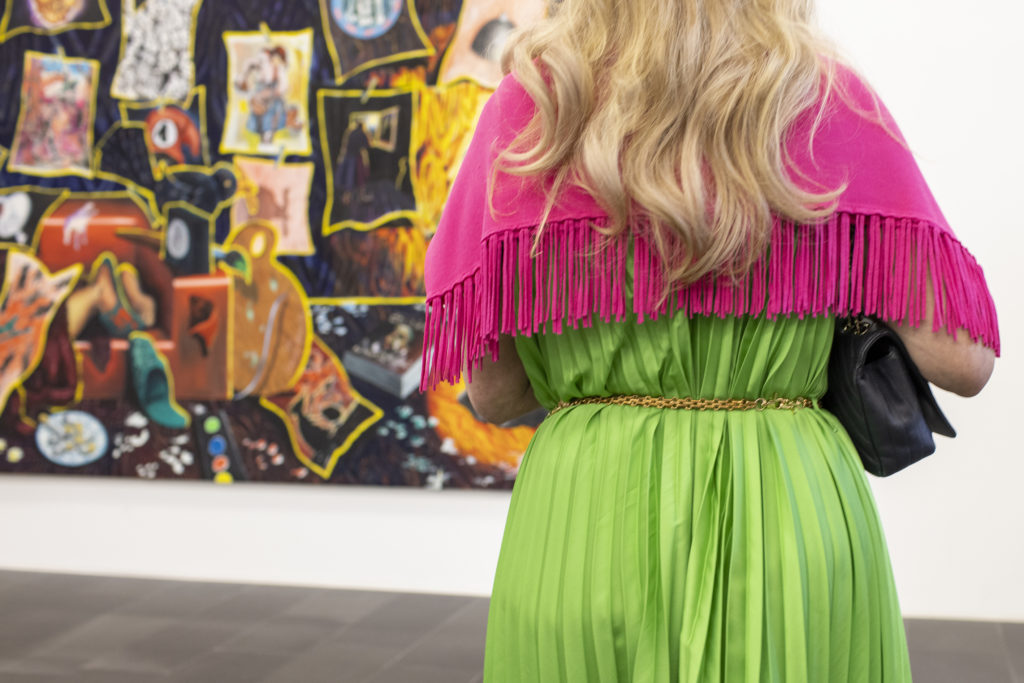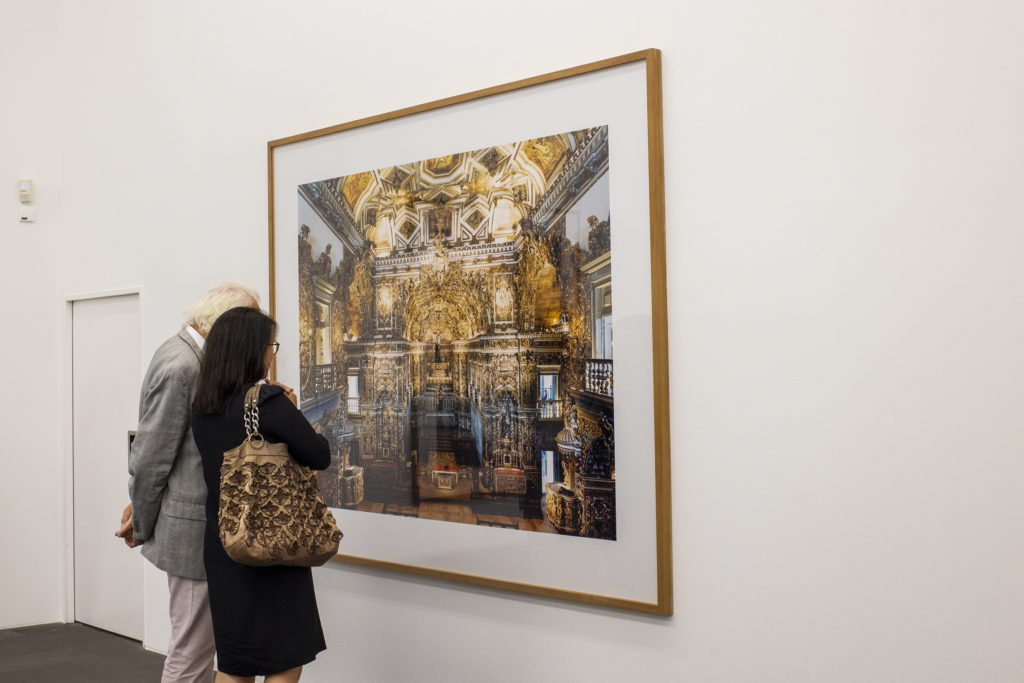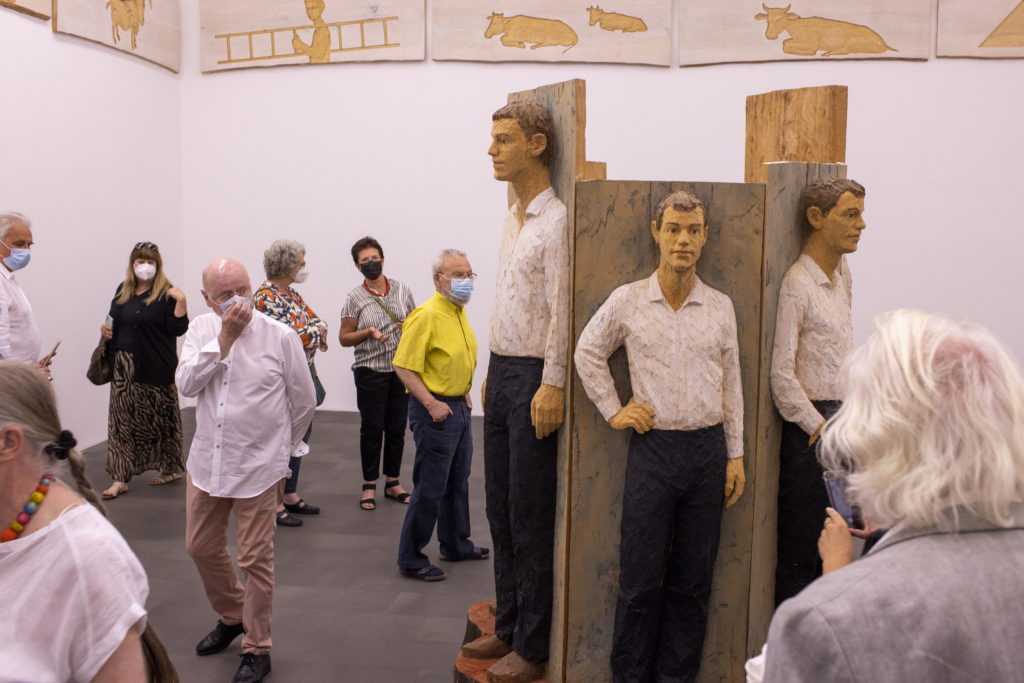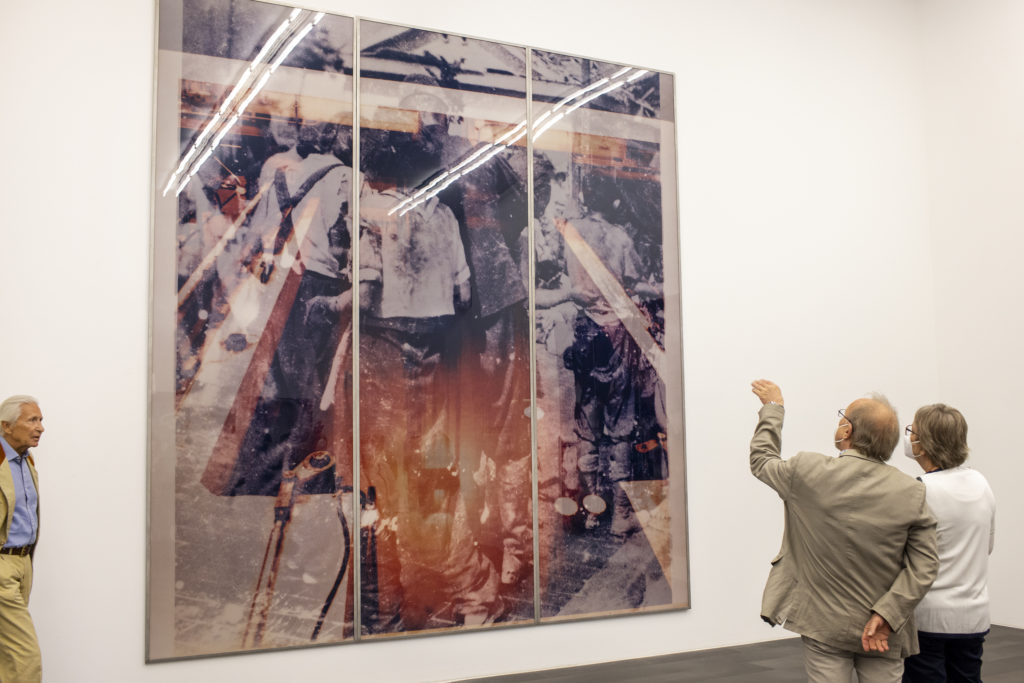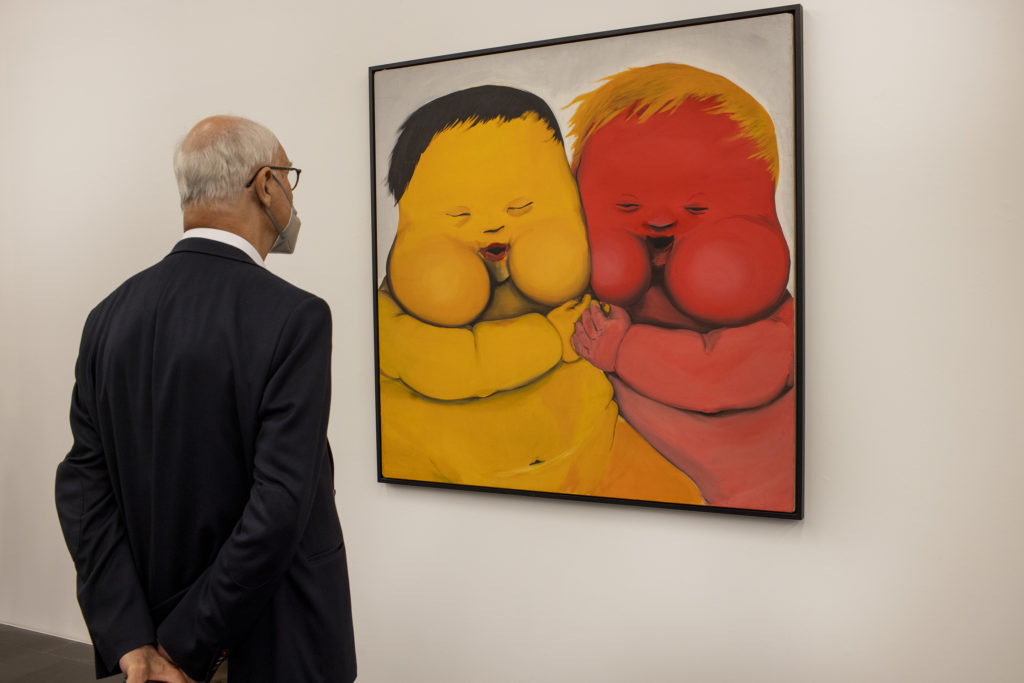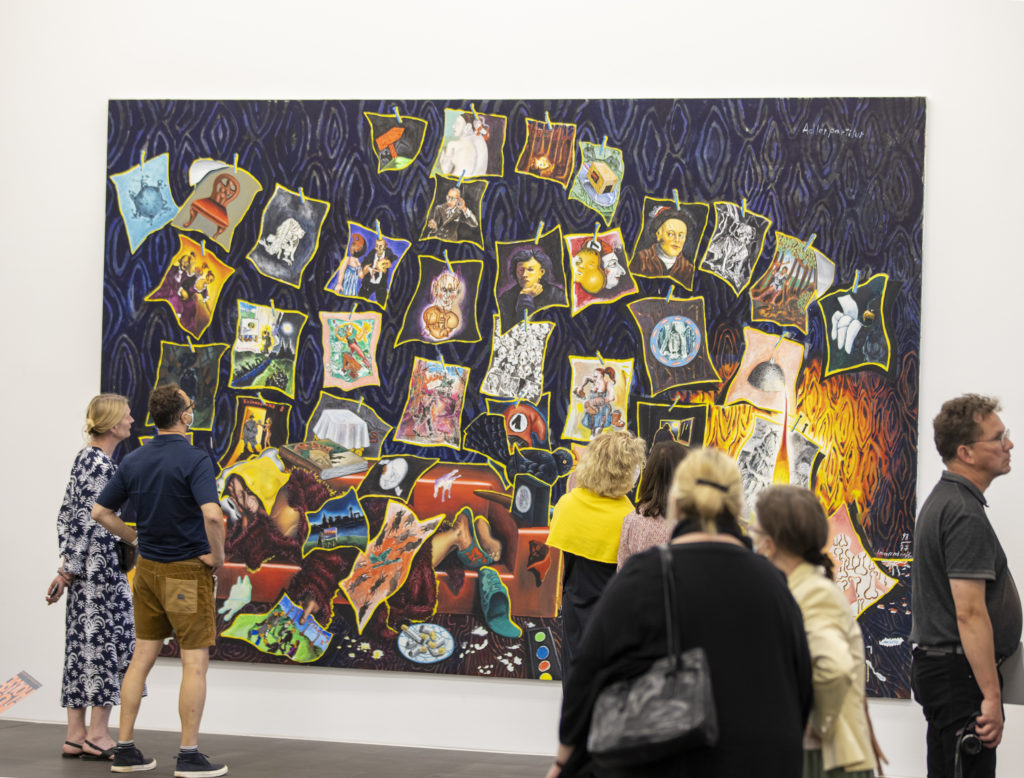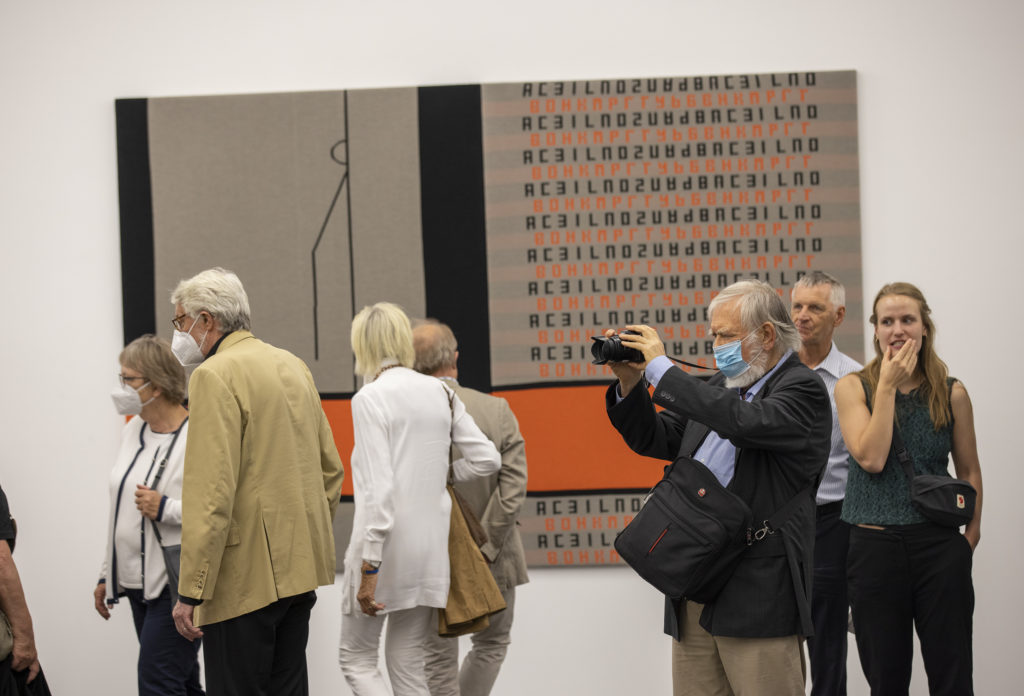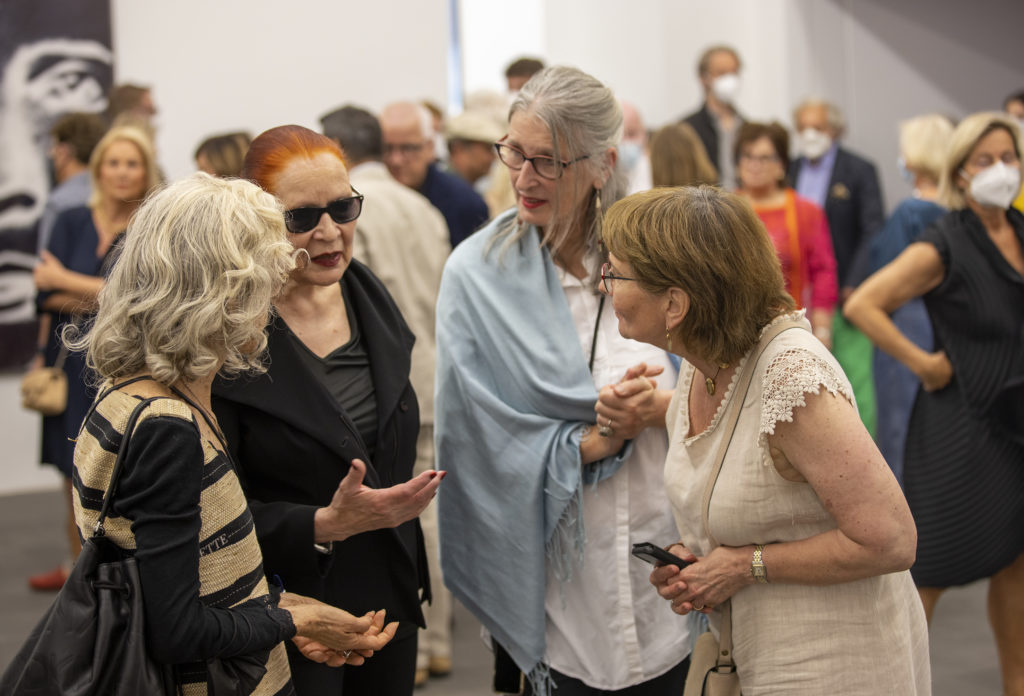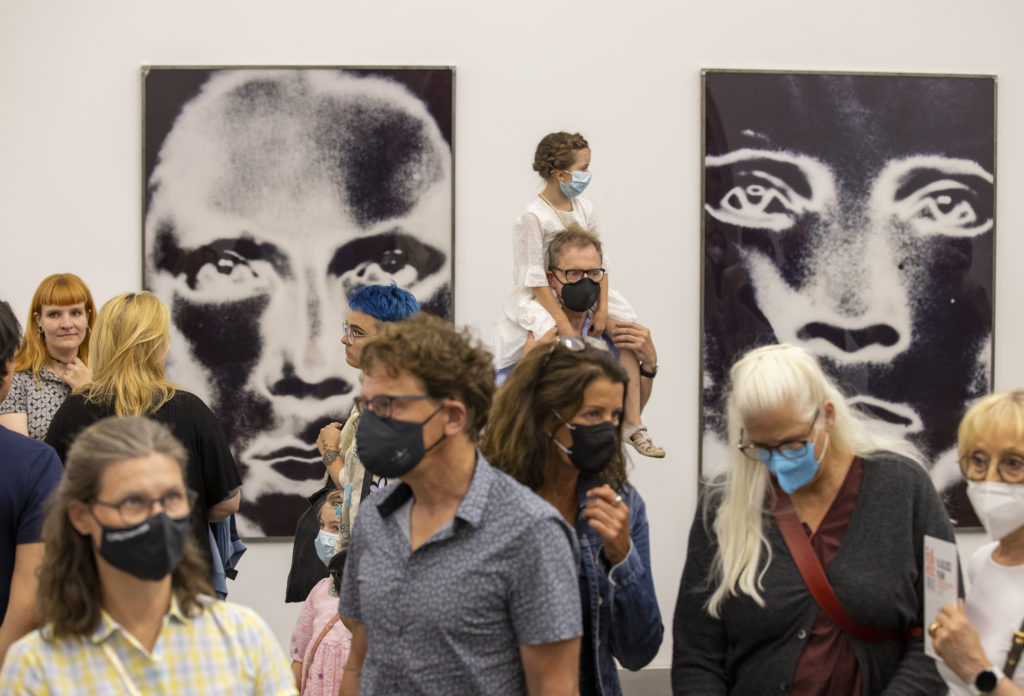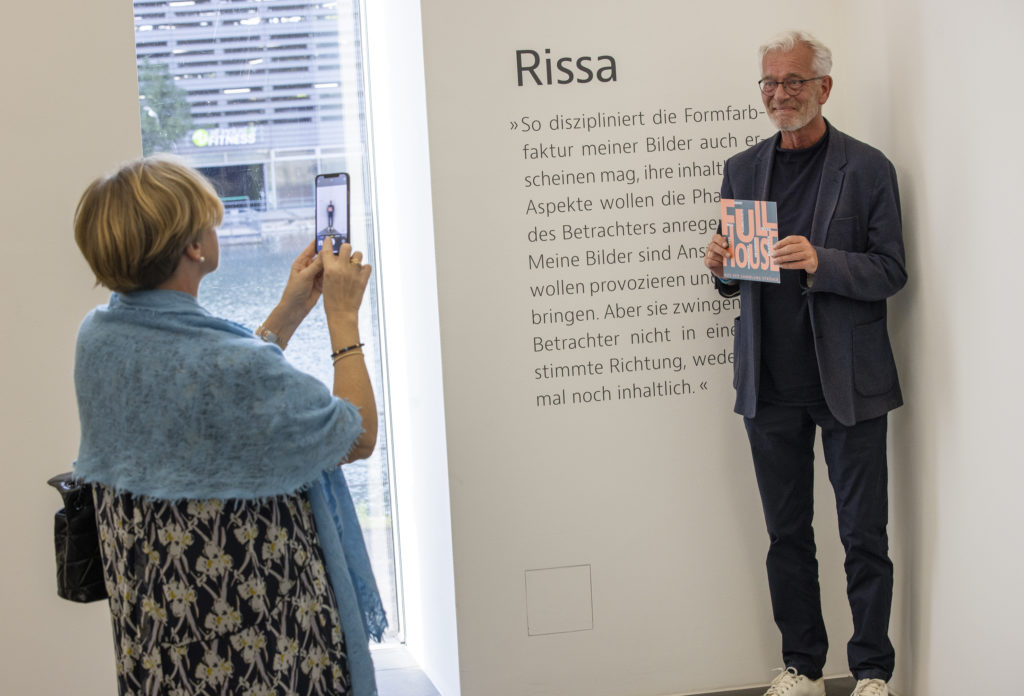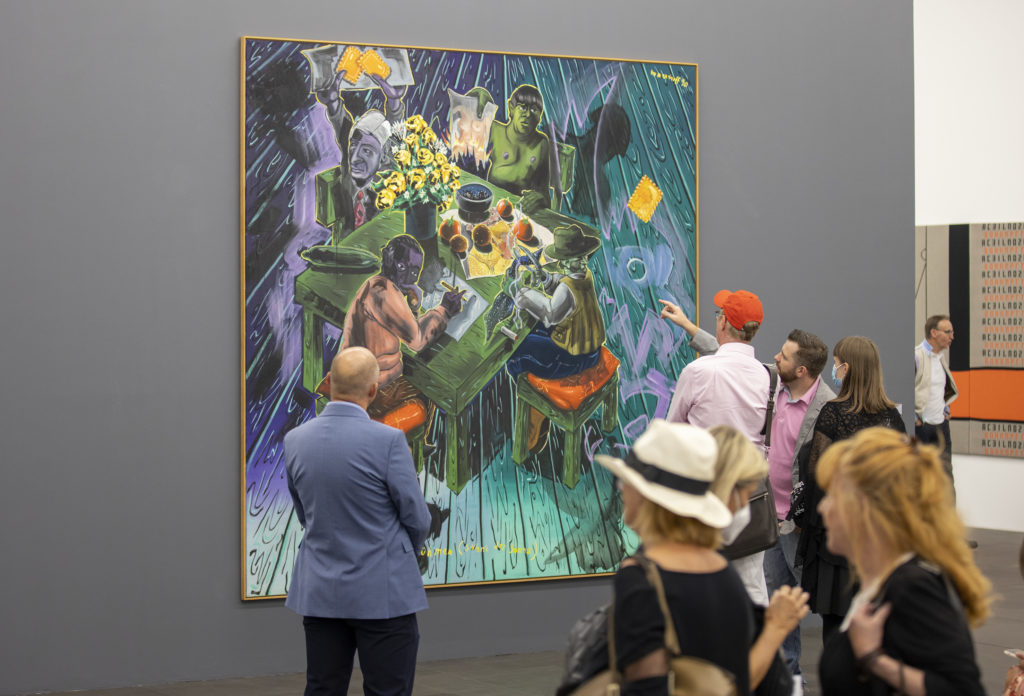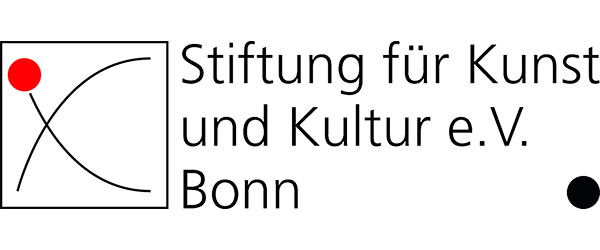July 15th until october 9th 2022
MKM Museum Küppersmühle for Modern Art, Duisburg
From July 15, 2022, the MKM’s motto will be: collection “FULL HOUSE”. For in its summer exhibition, the Museum Küppersmühle is presenting further artists from the Ströher Collection in addition to the permanent collection presentation, thus drawing on a diverse spectrum of artistic productions from the 1960s to the present day. On view are photographs by Thomas Florschuetz, Candida Höfer, and Katharina Sieverding, knitting and hearth pictures by Rosemarie Trockel, paintings by Rolf-Gunter Dienst, Jörg Immendorff, and Rissa, and an installation by sculptor Stephan Balkenhol.
Dienst’s painting is quietly intellectual, Rissa’s is powerful and geometric, Immendorff’s is energetic and full of reminiscences of art history. Civilization, architecture, and nature are themes of the photographic works by Höfer, Florschuetz, and Sieverding, while Balkenhol’s figures and Trockel’s wall works approach man and his social environment in different ways. The path through the rooms opens up surprising perspectives, angles and lines of sight between the works, allowing visitors to experience art in a new way.
Complementing the collection’s permanent exhibition focusing on informal and abstract postwar artists, the FULL HOUSE exhibition takes a look at the generation that followed. All of the artists presented have in common that they have maintained and further developed their significance for art history to this day:
“From today’s perspective, the diversity of the art scene, especially from the 1970s to the 1990s, would be inconceivable without the distinctive signature of the artist:s exhibited here. With FULL HOUSE, we provide insight into the Ströher Collection – throughout the MKM – and thus also into the iconography of German art after 1945 with an unalterable status,” says MKM Director Walter Smerling.
➜To the accompanying program.
➜ Tickets.
Opening speech by Rissa
Dearly beloved, or should I say:
Dear Sir or Madam and all others for whom this classic form of address does not meet their specific needs?
Here in this beautiful building four male and four female artists exhibit:
Works by two painters and a painter, by two photographers and a photographer, by a multimedia artist and by a sculptor. Two painters are already unfortunately no longer with us. In any case, we who are still alive are glad that visitors here want to look at our works!
Surprisingly for me, I have been asked by Walter Smerling to give a speech on this artist/artist exhibition Full House.
I was surprised by this choice, because I am not a speaker. I live very secluded to paint, read, think and sometimes write. Rather, I am a storyteller who is very happy to answer questions when they are asked to me by some friends or other people. Here I will probably not be asked any questions by the honored attendants for the time being, therefore I have to ask them myself, otherwise my thinking and speaking will get going too slowly.
I have two questions:
First
Why was I, of all people, chosen by Walter Smerling to give a speech here?
Second
What am I supposed to tell as an old painter, if I am not allowed to characterize the art of other colleagues, nor do I want to?
I answer the first question as follows:
I, Rissa, born in 1938 in Chemnitz in Saxony, was chosen for the speech because at 84 years of age I am the oldest artist who, fortunately, will now be able to show some of her works from the Sylvia and Ulrich Ströher Collection in this new magnificent building in Duisburg in 2022 with four younger colleagues and three female colleagues in addition to myself. In addition, the Küppersmühle has become an important home for me and my paintings since 2003, because in this year, in this place, one of the most beautiful Rissa exhibitions of a non-provincial nature in Germany took place. Moreover, even after the death of my husband and informal painter K.O. Götz (who lived from 1914 to 2017), I continue to have a deep friendship with Sylvia and Ulrich Ströher, with Ina Hesselmann, and of course with Walter Smerling.
I just mentioned my age. Coming back to the age of the three other female artists and four male artists exhibiting here, I imagined that we were not only emotionally connected in the short term through this exhibition, but that we were really related to each other. So I came to the conclusion to talk about our ages as well:
Katharina Sieverding, born in 1941, was born in Prague, Czechoslovakia (now the Czech Republic). She is a famous photo artist with a claim to have pioneered here. I know her only vaguely from our student days at the Düsseldorf Art Academy. She was a student of Joseph Beuys (1921 – 1986), and I was a student of K.O. Götz from 1960. By the way, Beuys owes it to this non-figurative painter, among others, that he was able to become a professor at the Düsseldorf Art Academy.
Back to the two of us as art students. During our student years, our paths rarely crossed in the long empty academy hallways. And when we did meet, Katharina and I smiled at each other as if we knew more about each other than was the case. I could have been her sister three years older.
Rolf Gunter Dienst was born in Kiel in Schleswig-Holstein in 1942. Unfortunately, he died much too early in 2016.
K.O. Götz and I had a long, friendly relationship with this painter and writer. He visited Götz already in his younger years around the 1960s in Düsseldorf and then later in 1978 also in our house in Niederbreitbach. There is a beautiful photo of this visit by the three of us in the second volume of K.O. Götz’s autobiography “Erinnerung und Werk”. I myself visited Rolf-Gunter Dienst for the last time in 2013 with Ina Hesselmann in his apartment in Berlin, and we were amazed how he patiently-optimistically showed us his wonderfully brilliantly colorfully constructed pictures there. K.O. Götz, Rolf-Gunter Dienst and I were visually-aesthetically and intellectually on the same wavelength and connected in true friendship. He was a painter with a strong character and a hot heart, and a liberal arts writer for all art movements that developed in the Western world after World War 2. Vintage-wise, I could have been his sister four years older.
Candida Höfer, the vaunted, formidable photographer whom I unfortunately did not meet in person before this exhibition. She was born in 1944 in Eberswalde in Brandenburg, but grew up in Cologne after 1945. The formal rigor of her photographs, which also characterizes my painting, connects us artistically. I could be her sister six years older.
The painter Jörg Immendorff was born in Bleckede, Lower Saxony, in 1945. Unfortunately, he died too early in 2007 from ALS. He was a powerful, loyal painter colleague of mine at the Düsseldorf Art Academy from 1996.
K.O. Götz, in his liberal manner, had even once provided him with a painting space in one of his classrooms for the semester break during his studies with Joseph Beuys. Immendorff never forgot this concession by Götz. Although he did paint against non-objective informal painting with his particular, politically tinged kind of figurative painting.
For Immendorff’s 60th birthday in 2005, K.O. Götz and I were specially invited to his birthday party at Markus Lüpertz’s private studio in Düsseldorf. There, sadly, we both saw Immendorff for the last time, as he accepted the congratulations of all present in a wheelchair. I, Rissa, could have been his seven year older sister in terms of year.
Rosemarie Trockel was born in 1952 in Schwerte in North Rhine-Westphalia. In her case, by the way, the fact is confirmed that visual form ability and vivid imagination is often inherited from father to daughter and from mother to son. And – “Voilà”: Her father is a mechanical engineer! Rosemarie and Rissa were thus artist colleagues at the Düsseldorf Art Academy from 1998 to 2007.
In 2007 I left the academy by age, she only in 2016. She, unlike me, is a much-acclaimed multi-media artist who not only creates interesting black and white and color works, but she has also entered the spiritual realm of Marcel Duchamp (1887-1968) by also making sculptures, sculptures, objects, video works, and installations.
Now I should say a few words about my intention as “only” a classical painter and draftswoman, because with my painting I strive visually-aesthetically for my own artistic conception, which can be called old-fashioned “own style”. I want to consciously create a distinctive artistic visual world with my painting, which shows images that are aesthetically and semantically unique. Only time will tell whether I have succeeded in doing so. Today, however, it is becoming increasingly clear that finding one’s own style is becoming more and more difficult for artist painters because we live in an age where the human longing for images, which satisfied the classic panel painting until the invention of photography, is now increasingly satisfied by film, television and the Internet… In addition, in the flood of images in painting, a mixing of classical and modern formal elements is in full swing, opening the door to eclecticism and visual redundancy in painting. In addition, to put it harshly, in my opinion, today works of art as two-dimensional planar picture templates with visually-aesthetically renewed picture elements are socially almost no longer expected and often no longer recognized, since the visual-aesthetic dimension of painting is talked about less and less.
Back to the academy days, when Markus Lüpertz (born 1941), as the new rector, began to brilliantly lead the academy in Düsseldorf from 1988: At that time, Rosemarie Trockel and I hardly ever had any contact with each other as colleagues, because I was born in 1938, belonged to an older generation, and was absent from the general art scene for most of my life. Rosemarie probably doesn’t know that at the time of her appointment, I had been the Academy’s Equal Opportunity Officer since 1988 and that I, too, contributed to her being appointed in 1998. Of course, I was pleased that a high-caliber female artist had finally been given a professorship, because it was one of my tasks to ensure that there were young women at the academy. Later, with my participation, the US-American Rita McBride (born 1960) joined the group. It should also be reported that Rosemarie Trockel and I never had a face-to-face encounter in the Academy. This happened once, when I had the opening of my picture exhibition here in the Küppersmühle in 2003, she was briefly present at the opening and surprisingly called out to me that they were good pictures. I was quite amazed. Vintage-wise, I’m 14 years older than her, so I could have been both her sister and – dare I say it – even her mother.
Thomas Florschuetz, born in Zwickau in Saxony in 1957, lived in West Berlin from 1988. He is an experimental photographer. I only learned about some of his work through Wikipedia now that we are exhibiting here. What connects me to him is that he had a connection to the GDR until 1988 that I had until 1953. And that he, like me in my painting, deals photographically with unusual problems of form. I could easily be his mother with a 19-year age difference.
Stephan Balkenhol was born in Fritzlar in Hesse in 1957. Today he is a powerful rock in sculpture. I didn’t know him personally before this exhibition, but his wood sculptures are very appealing to me as a viewer to look at them for a long time. What connects the intention of my works with that of his sculptures are the concepts of “mystery” and “enigma”. These two words, sometimes triggering emotional desire, I have also often heard from viewers in front of my paintings. We are 19 years apart in age, so I could be his mother.
Now my speech has become quite long.
Nevertheless, we would like to thank all the exhibitors who have worked tirelessly for this exhibition, both ideally and practically.
That’s it, ladies and gentlemen!
Impressions of the opening
